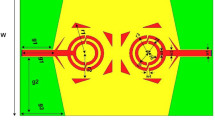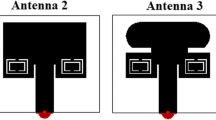Abstract
A dual band metamaterial loaded CPW-fed antenna for GSM, WLAN, LTE and RFID applications is presented in this paper. Metamaterials are new artificial materials which are used to achieve the physical properties that do not exist in natural materials. Here, the metamaterial provided gain enhancement for the proposed antenna. The overall size of the proposed antenna is 114 × 114 mm2. The proposed antenna is imprinted on FR4 substrate with a relative permittivity 4.5, loss tangent 0.02 and thickness 0.8 mm. For the gain improvement and bandwidth enhancement, antenna is modified using a complimentary circular split ring resonator (CSRR). The measured dual band operating frequency is in the range of 0.92–2.76 GHz and 5.02 GHz–7.11 GHz. The circular unit cells are utilized to resonate the antenna at 1.8 GHz and 5.7 GHz, respectively. Thus, the proposed antenna is suitable for GSM, WLAN, LTE and RFID applications.
Access provided by Autonomous University of Puebla. Download conference paper PDF
Similar content being viewed by others
Keywords
1 Introduction
In today’s fast developing world, the most unavoidable thing in our life is mobile phone. As its need is increasing, the requirement of wireless technologies such as GSM, LTE, and WLAN [1] is also increasing. The rapid growth of mobile phones is also leading to a threat of harmful radiations from these mobile phones and the subsequent health problems. Since no one can think about avoiding the phones, the only possible solution is to reduce the radiation emitted by the mobile phones [2]. Certain methodologies have to be implemented while designing these mobile phones. When compared with the conventional antennas, the metamaterial antenna decreases the number of the antenna elements and enhances antenna performance. Metamaterial-supported antennas will have gain improvement, [3] bandwidth enhancement, high efficiency, etc. The highly efficient antennas are in a huge demand especially to work in service bands like global system for mobile communication (GSM-900, GSM-1800), [4] wireless LAN(WLAN) at 2.4 GHz [5] and 5 GHz, long-term evolution (LTE) [6] cover three bands (698–966 MHz, 1.427–2.69 GHz, 3.4–3.8 GHz), etc. [7]. The enhanced performance of metamaterial antennas makes them highly potential structures in wireless communication systems.
2 Metamaterials
The word metamaterial is derived from Greek word ‘meta’ and Latin word ‘materia’ meaning beyond and matter, respectively [8]. Metamaterials are artificial materials on which a particular property is being induced which the material does not possess naturally. These property may be due to its shape, structure, size or the geometry which it has, leading to changes in the electromagnetic property of the material [9]. So these properties are not derived from the base materials but from the internal microstructure [10]. The core objective of usage of metamaterial is that these materials help us to achieve the desired properties [11]. These desired properties are achieved, when necessary changes are made in the geometry which results in change in refractive index [12], either to a positive value, or a negative value resulting in achieving the property.
3 Split Ring Resonator
Split ring resonators (SRR) are structures which consist of two metallic rings that are etched on the dielectric material, and they also consist of slit which are etched at opposite sides [13]. These are structures that are mainly used by metamaterials in order to get the derived property [14]. It is mainly used for producing desirable magnetic susceptibility. Split ring resonators are having strong magnetic coupling and they are much more than ferromagnetic materials. Several kinds of split ring resonators are present and one such is complementary split ring resonator (CSRR) (Fig. 1).
4 Antenna Design
Antenna 1 in Fig. 5a is the initial antenna with a CPW L-shaped fed structure. Apparently on the dielectric substrate of the CPW structure, a lump with two diminished slits ground electrodes lied alongside and parallel to the strip on the same surface. It is fabricated using FR4 substrate which is having a relative permittivity of 4.5, loss tangent of 0.02 and thickness of 0.8 mm. The material is capable of retaining its mechanical characteristics and electrical insulation in dry as well as wet conditions. Along with good manufacturing, it can be utilized for various mechanical and electrical applications. All the dimensions of the antennas are in millimetres (mm). The substrate is in a square shape with an edge G1, and the overall size was 114 × 114 mm.
The geometry has L-shaped microstrip line acting as the patch. Here, dual band is obtained, but at lower frequencies the antenna gain and bandwidth are less. Usually for the gain improvement and bandwidth enhancement metamaterials are used, as they are utilized for achieving the desired properties. The antenna is modified by using a complementary circular split ring (CSRR)-based metamaterial as shown in Fig. 2b. The circular unit cell used in the antenna structure is shown in Fig. 2c. The complementary split ring is placed at the bottom of the CPW and is utilized to resonate at 1.8 GHz and 5.7 GHz, respectively. We obtained a band of 0.92–2.76 GHz and 5.02–7.1 GHz where 1.8 GHz and 5.7 GHz are included in these bands so that the proposed antenna is suitable for GSM, WLAN, LTE and RFID applications.
5 Results and Discussion
5.1 Return Loss
The return loss plot, VSWR, radiation patterns and 3D polar plots are shown in Figs. 3, 4 and 5.
Return loss plot for the antennas shown in Fig. 3
Return loss values of − 18.9, − 11.2 dB are obtained at 1.8 and 5.7 GHz for antenna without metamaterial and − 24db, − 20.5db are obtained at 1.8 GHz and 5.7 GHz for antenna with metamaterial which is useful for GSM, WLAN, LTE and RFID applications.
5.2 VSWR
The values of VSWR are 0.93 and 1.54 at 1.4 and 5.2 GHz for antenna without metamaterial. The values of VSWR are 1.05 and 1.7 at 1.8 GHz and 5.7 GHz for antenna with metamaterial. This shows that the proposed design is well matched and antenna is well suited for GSM, WLAN, LTE and RFID applications (Fig. 4).
VSWR for the antennas shown in Fig. 1
5.3 Radiation Pattern
Figure 5a, b depicts the radiation pattern of antenna 1 in Fig. 2. Figure 5c, d depicts the radiation pattern of antenna 2 in Fig. 2. The variation of the power radiated by an antenna as a function of the direction away from the antenna is depicted by the radiation pattern of an antenna [5]. Figure 5a shows the radiation pattern centred at 1.4 GHz which is slightly deviated. Figure 5b shows the radiation pattern at 5.2 GHz which is more deviated than the pattern at 1.4 GHz. Figure 5b shows the radiation pattern centred at 1.8 GHz and Fig. 5c shows the radiation pattern at 5.7 GHz. It shows that at higher frequencies the radiation pattern undergoes distortion.
5.4 Gain
Figure 6a, b represents the 3D polar plot of the antenna 1 shown in Fig. 5. Figure 6c, d represents the 3D polar plot of the antenna 2 shown in Fig. 2. It can be observed from the plots that the gain at 1.4 GHz and 5.2 GHz is 2.5 dB and 5 dB. The gain at 1.8 GHz and 5.7 GHz is 4.8 dB and 6.2 dB, respectively. Hence, it shows that the gain is increased when antenna structure is modified using metamaterial.
This project mainly emphasizes on wireless bands, which mainly includes global system for mobile communication (GSM), wireless local area network (WLAN), long-term evolution (LTE) and radio frequency identification (RFID) applications. We could see that the designed antenna could be effectively used in these wireless band frequencies.
6 Conclusion
The evolution in wireless communication and electronic warfare systems in new era led to the emergence of metamaterial antennas resulting in increasing the efficiency or performance of the antenna to a greater extent. In order to adapt with the wireless communication systems in this modern era, ‘A dual band metamaterial loaded CPW-fed antenna for GSM, WLAN, LTE and RFID applications’ is introduced. The antenna is designed in two stages by introducing and without the complimentary split ring resonators. It was found that by using complimentary split ring resonators the antenna is able to provide high gain and bandwidth. The results obtained after simulation ensure that the antenna functions well in the lower (0.92–2.76 GHz) as well as in upper (5.02–7.11 GHz) frequency range. Since it covers the frequency band of GSM, WLAN, LTE and RFID, it is possible to use this antenna in these applications. The fabrication of antenna is much easier as well as it is simple, economical and also appropriate for small portable devices.
References
Krzysztofik WJ, Cao TN (2018, November 5) Metamaterials in application to improve antenna parameters. Metamaterials Metasurfaces Josep Canet-Ferrer, IntechOpen. https://doi.org/10.5772/intechopen.80636
Aznar F, Gil M, Siso G, Bonache J, Martin F (2009) SRR- and CSRR-based metamaterial transmission Lines: modeling and comparison. In: 2009 IEEE MTT-S international microwave workshop series on signal integrity and high-speed interconnects, Guadalajara, 2009, pp 49–52. https://doi.org/10.1109/IMWS.2009.4814907
Caloz C, Itoh T (2006) Electromagnetic metamaterials: transmission line theory and microwave applications. Wiley, New Jersey
Iyer AK, Eleftheriades GV (2002) Negative refractive index metamaterials supporting 2-D waves. In: IEEE-MTT international microwave symposium, vol 2, Seattle, WA, pp 412–415
Siwiak K, McKeown D (2004) Ultra wideband radio technology
Park S-Y, Oh S-J, Park J-K (2010) A simple CPW Fed UWB antenna design. J Koren Inst Electromagn Eng Sci
Antonino-Daviu E, Cabedo Fabres M, Ferrando Bataller M, Valero-Nogueira A (2003) Wideband double-fed planar monopole antennas. Electron Lett
Subbarao A, Raghavan S (2014) Compact coplanar waveguide-fed planar antenna for ultra wideband and WLAN applications, wireless personal communications. Kumar A, Shanmuganantham T (2014) A CPW fed octagonal patch UWB antenna with WiMAX band notched. Commun Embed Syst (ICICES2014)
Lu G, von der Mark S, Korisch I, Greenstein LJ, Spasojevic P (2004) Diamond and rounded diamond antenna for ultra wideband communications. IEEE Antennas Wirel Propag Lett
Abdalla MA, El-Sobky NA, El-Gabry MN (2016) Metamaterials inspired dual-wide band CPW-fed antenna using split ring resonator structure. In: 10th international congress on advanced electromagnetic materials in microwaves and optics—metamaterials
Kukreja J, Kumar Choudhary D, Kumar Chaudhary R (2017) CPW fed miniaturized dual-band short-ended metamaterial antenna using modified split-ring resonator for wireless application. Wiley Int J RF Microwave Comput Aided Eng
Denceli D, Yogeshwaran A (2016) Split ring resonator metamaterial antenna for WiMax/WLAN applications. In: 2016 online international conference on green engineering and technologies (IC-GET)
Pandeeswari R, Samson Daniel R, Deivalakshmi S, Raghavan S (2017, November) Non-bianisotropic split ring resonator based CPW-fed dual band antenna. In: Proceedings of the 2017 IEEE region 10 conference (TENCON)
Ashok Kumar S, Shanmuganantham T, Dileepan D (2017) Design and development of CPW fed monopole antenna at 2.45 GHz and 5.5 GHz for wireless applications. Alexandria Eng J 56:231–234 (2017)
Author information
Authors and Affiliations
Corresponding author
Editor information
Editors and Affiliations
Rights and permissions
Copyright information
© 2022 The Author(s), under exclusive license to Springer Nature Singapore Pte Ltd.
About this paper
Cite this paper
Ansal, K.A., Kuruvilla, A.A., Keerthana, S., Harries, K.M., Johns, V.S., Raj, A. (2022). A Dual Band Metamaterial Loaded CPW-Fed Antenna for GSM, WLAN, LTE and RFID Applications. In: Sivasubramanian, A., Shastry, P.N., Hong, P.C. (eds) Futuristic Communication and Network Technologies. VICFCNT 2020. Lecture Notes in Electrical Engineering, vol 792. Springer, Singapore. https://doi.org/10.1007/978-981-16-4625-6_45
Download citation
DOI: https://doi.org/10.1007/978-981-16-4625-6_45
Published:
Publisher Name: Springer, Singapore
Print ISBN: 978-981-16-4624-9
Online ISBN: 978-981-16-4625-6
eBook Packages: EngineeringEngineering (R0)










